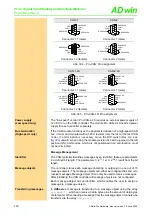
ADwin-Pro
Hardware, manual version 2.9, June 2006
185
Pro I: Signal Conditioning and Interface Modules
Pro-Inter-SL Rev. A
ADwin
Depending on the configuration, the module can be a digital slave (ID 3) or a
PCP participant (ID 243). As digital slave the module cannot exchange acycli-
cal data with the bus master.
If during initialization of the fieldbus interface with
INIT_SLAVE
an area for
parameter data is indicated, then the module is a PCP participant. (The return
parameters
Par_in
and
Par_out
are not equal to zero). If the return param-
eters are equal to zero the module is a digital slave.
shows a bus layout
with a module as PCP participant.
Fig. 320 – Pro-INTER-SL: Bus layout in the configuration tool
Baud rate
The Baud rate in the Interbus is 500 kBit/s, other transfer rates are not avail-
able. The module supports this Baud rate.
Configuring the slave
Input and output areas
When using an Interbus, an area for cyclic and acyclic data can be indicated
during initialization of the fieldbus interface (see
INIT_SLAVE
). In the Interbus
area sizes are indicated in words (1 word = 2 bytes); thus an input and output
area of this size is specified, because the structure of the Interbus requires
equally large areas for the input and output data.
The size of the area for cyclic data can be in the range of 1 ... 10 words.
The standard size für the PCP channel in the Interbus is 32 words for either
input or output. This size is recommended, but not absolutely required. For the
Pro-INTER-SL module the size of the area can be in the range of 1 ... 200
words.
PCP channel
The parameter channel is considered in the protocol with 1 word. That means
that 2 bytes from the acyclic data are transmitted each cycle. Therefore the
(acyclic) transmission of the parameter data is slower than the transmission of
the cyclic data. The time needed for transmitting the parameter data is evalu-
ated by the product of the bus cycle time and the number of the words to be
transmitted in the parameter data set.






























